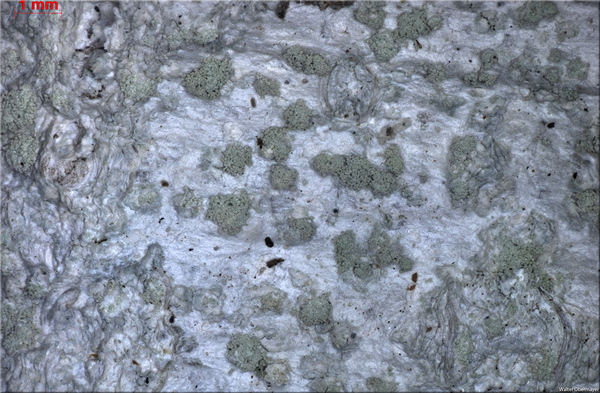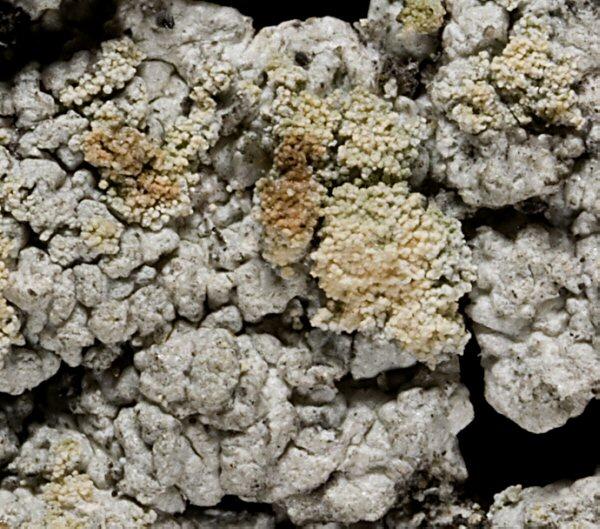Ochrolechia arborea (Kreyer) Almb.
Bot. Not.: 254, 1952. Basionym: Variolaria lactea var. arborea Kreyer - Acta Horti Petropolit., 31: 322, 1913.
Synonyms: Lecanora perleprosa Räsänen; Ochrolechia arborea var. albula (Savicz) Makar.; Ochrolechia sordidogrisea (Erichsen) E. Schreiner & Hafellner; Pertusaria arborea (Kreyer) Zahlbr.; Pertusaria arborea f. albula (Savicz) Erichsen; Pertusaria myriosora Erichsen; Pertusaria sordidogrisea Erichsen; Variolaria arborea (Kreyer) Ljub.; Variolaria arborea var. albula Savicz
Distribution: N - VG (Castello 1996, 2002, Martellos & Castello 2004), Frl, Ven (Nascimbene & Caniglia 2000, 2003c, Thor & Nascimbene 2007, Nascimbene 2008c, 2011), TAA (Nascimbene 2006b, 2008b, 2014, Thor & Nascimbene 2007, Nascimbene & al. 2007b, 2009, 2010, 2014, 2022, Nascimbene & Marini 2015, Nimis & al. 2015, Trindade & al. 2021), Lomb, Piem (Isocrono & al. 2004), Emil (Nimis & al. 1996, Tretiach & al. 2008, Fariselli & al. 2020), Lig (Brunialti & al. 2001). C - Tosc (Tretiach & Nimis 1994, Benesperi 2011), Marc (Nimis & Tretiach 1999), Umb (Ravera 2000, Ravera & al. 2006), Laz, Abr (Nimis & Tretiach 1999, Gheza & al. 2021), Mol (Nimis & Tretiach 1999, Caporale & al. 2008, Genovesi & Ravera 2014, Caporale & Ravera 2020), Sar (Zedda 1995, 2002, Rizzi & al. 2011, Di Nuzzo & al. 2022). S - Camp (Aprile & al. 2003b, Nimis & Tretiach 2004, Garofalo & al. 2010, Brunialti & al. 2013, Ravera & Brunialti 2013, Catalano & al. 2016), Pugl (Nimis & Tretiach 1999), Bas (Nimis & Tretiach 1999), Cal (Puntillo 1995, 1996, Incerti & Nimis 2006), Si (Nimis & al. 1996b, Grillo 1996).
Description: Thallus crustose, forming more or less orbicular patches, very thin at margin to somewhat thicker in the older central areas, smooth to rarely verruculose, shiny, yellowish grey to (rarely) yellowish white, sorediate. Soredia greenish to pale yellow-green, more rarely yellowish white, usually coarsely granular, 40-50 μm wide, arranged in small, round, discrete, crater-like, usually <0.6 mm wide soralia which may become confluent in old specimens. Apothecia extremely rare, lecanorine, up to 1.8 mm across, with a flesh-coloured, concave to flat, epruinose disc and an even, pink-brown, esorediate or partly sorediate thalline margin, without salmon pink discoid tissues. Photobiont chlorococcoid. Spot tests: cortex and soralia K-, C+ red, KC+ red, P-; medulla C-, KC-; soralia UV+ bright orange. Chemistry: lichexanthone, gyrophoric acid (major), and lecanoric acid (trace). Note: a mainly temperate lichen found on isolated deciduous trees with mineral-rich bark. According to Kukwa (2011) the species is more frequent in Fennoscandia and central-eastern Europe, being rare in the western and southern parts of the Continent.
Growth form: Crustose
Substrata: bark
Photobiont: green algae other than Trentepohlia
Reproductive strategy: mainly asexual, by soredia, or soredia-like structures (e.g. blastidia)
Commonnes-rarity: (info)
Alpine belt: absent
Subalpine belt: absent
Oromediterranean belt: absent
Montane belt: very rare
Submediterranean belt: rather rare
Padanian area: extremely rare
Humid submediterranean belt: rather rare
Humid mediterranean belt: absent
Dry mediterranean belt: absent

Predictive model
Herbarium samples
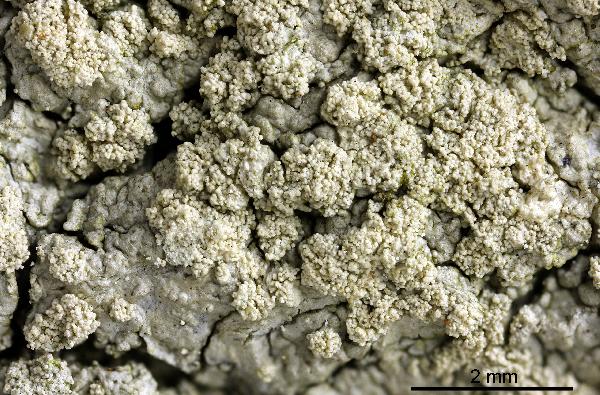

Felix Schumm - CC BY 4.0
[9592], Baden-Württemberg, Kreis Göppingen, Wangen, im Quercus-
Carpinus-Wald Breitenloh östlich des kleinen Teichs von Oberwälden,
48°44.337 N, 9°35.586 E, 440 m. TK: 7223. Leg. F. & D. Schumm,
07.07.2002, det. F. Schumm, 07.07.2002. - Chemistry p128/6: gyrophoric
(major), lecanoric (minor), Lichexanthon; Acetonfleck ++ gelb;
UV:++ leuchtend orangegelb.


P.L. Nimis; Owner: Department of Life Sciences, University of Trieste
Herbarium: TSB (31770)
2001/12/05
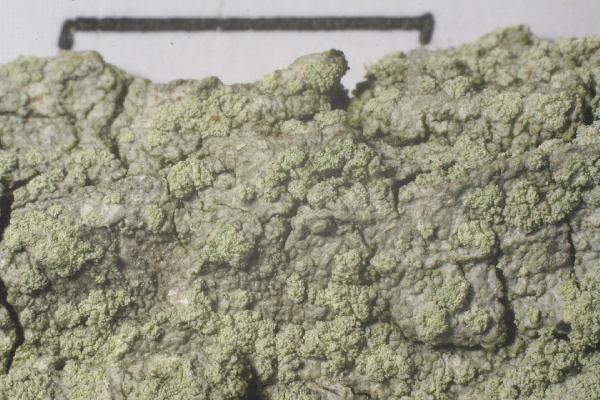

Felix Schumm - CC BY 4.0
[9592], Baden-Württemberg, Kreis Göppingen, Wangen, im Quercus-
Carpinus-Wald Breitenloh östlich des kleinen Teichs von Oberwälden,
48°44.337 N, 9°35.586 E, 440 m. TK: 7223. Leg. F. & D. Schumm,
07.07.2002, det. F. Schumm, 07.07.2002. - Chemistry p128/6: gyrophoric
(major), lecanoric (minor), Lichexanthon; Acetonfleck ++ gelb;
UV:++ leuchtend orangegelb.
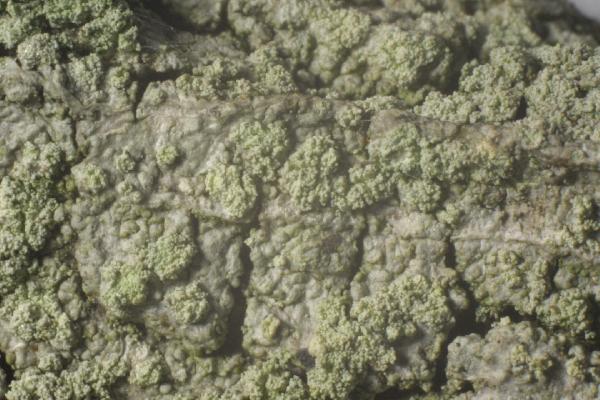

Felix Schumm - CC BY 4.0
[9592], Baden-Württemberg, Kreis Göppingen, Wangen, im Quercus-
Carpinus-Wald Breitenloh östlich des kleinen Teichs von Oberwälden,
48°44.337 N, 9°35.586 E, 440 m. TK: 7223. Leg. F. & D. Schumm,
07.07.2002, det. F. Schumm, 07.07.2002. - Chemistry p128/6: gyrophoric
(major), lecanoric (minor), Lichexanthon; Acetonfleck ++ gelb;
UV:++ leuchtend orangegelb.
Growth form: Crustose
Substrata: bark
Photobiont: green algae other than Trentepohlia
Reproductive strategy: mainly asexual, by soredia, or soredia-like structures (e.g. blastidia)
Commonnes-rarity: (info)
Alpine belt: absent
Subalpine belt: absent
Oromediterranean belt: absent
Montane belt: very rare
Submediterranean belt: rather rare
Padanian area: extremely rare
Humid submediterranean belt: rather rare
Humid mediterranean belt: absent
Dry mediterranean belt: absent

Predictive model
| Herbarium samples |


Felix Schumm - CC BY 4.0
[9592], Baden-Württemberg, Kreis Göppingen, Wangen, im Quercus- Carpinus-Wald Breitenloh östlich des kleinen Teichs von Oberwälden, 48°44.337 N, 9°35.586 E, 440 m. TK: 7223. Leg. F. & D. Schumm, 07.07.2002, det. F. Schumm, 07.07.2002. - Chemistry p128/6: gyrophoric (major), lecanoric (minor), Lichexanthon; Acetonfleck ++ gelb; UV:++ leuchtend orangegelb.


P.L. Nimis; Owner: Department of Life Sciences, University of Trieste
Herbarium: TSB (31770)
2001/12/05


Felix Schumm - CC BY 4.0
[9592], Baden-Württemberg, Kreis Göppingen, Wangen, im Quercus- Carpinus-Wald Breitenloh östlich des kleinen Teichs von Oberwälden, 48°44.337 N, 9°35.586 E, 440 m. TK: 7223. Leg. F. & D. Schumm, 07.07.2002, det. F. Schumm, 07.07.2002. - Chemistry p128/6: gyrophoric (major), lecanoric (minor), Lichexanthon; Acetonfleck ++ gelb; UV:++ leuchtend orangegelb.


 INDEX FUNGORUM
INDEX FUNGORUM
 GBIF
GBIF
 DOLICHENS
DOLICHENS

